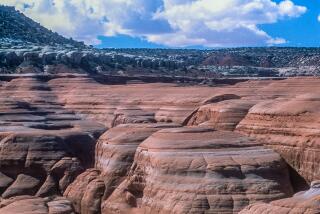A National Monument’s Changing Story
- Share via
Is it possible to write a bad book about the Grand Canyon?
At times in “How the Canyon Became Grand,” Stephen J. Pyne seems to prove that it is. But then Pyne’s genial nature and the magnificence of his subject combine to make this tale one worth looking at. The publishers are calling this book a “tour de force,” but they may be saying perhaps more than they intend. For the phrase means not only an “unusually skillful or ingenious creation, production or performance,” but also “one that is merely clever or spectacular.”
Pyne teeters between these definitions in this history of how the Grand Canyon has been perceived by various white settlers since Spanish conquistadors first arrived at the South Rim in 1540 in search of gold.
A professor of history at Arizona State University, Pyne is the author of the five-volume “Cycle of Fire” series including “Fire in America,” and a 1995 winner of the Los Angeles Times Book Prizes Robert Kirsch Award. For many years he was a member of the fire crew on the Canyon’s North Rim.
His thesis--for this book began as an academic thesis--is that the Grand Canyon has changed its shape in the human imagination as the human imagination itself has changed. For 256 years after the conquistadors it went unvisited by white settlers because “the apparatus for valorizing such phenomena did not exist” in that age. By “valorizing” Pyne evidently means “evaluating.”
Then in the 19th century came scientists, mostly geologists and explorers, who brought the canyon to the attention of America. They were joined by artists like Thomas Moran, whose romantic views of the West came to embody the mysterious grandeur of the Western landscape in the American public mind.
Tourists were lured by the Atchison, Topeka and Santa Fe railroads, whose sponsorship of Western artists and writers to publicize the wonders along its route had a profound effect on the way the Southwest is now seen. The automobile accelerated the tourist trade to the canyon’s South Rim.
Then, Pyne says, after World War II the current phase began: the wilderness preservation movement and eco-tourism. Even as the Colorado River that carved the canyon was dammed for most of its length, environmentalists fought successfully to keep its flow free. The number of people who raft through the canyon has risen dramatically, and it is now one of the great American outdoor things to do.
Pyne’s tour of the changing views of America’s unique canyon is engaging. He is at his best when he tells the stirring stories of the 19th century canyon heroes: of John Wesley Powell’s famous first voyage down the river; of the romantic, groundbreaking “Tertiary History of the Grand Can~on District” with its spectacular panoramic drawings by William H. Holmes. Pyne is warmly enthusiastic about Wallace Stegner’s great work, “Beyond the Hundredth Meridian: John Wesley Powell and the Second Opening of the West.”
But “How the Canyon Became Grand” is marred when the author overdoes his flights of fancy. For instance, he says that “it was no accident” that John Strong Newberry journeyed to the junction of the Grand and the Green rivers in the year that Charles Darwin published “Origin of Species” in 1859. But, of course, there was no connection between those events except that both took place in the same year and that both reflected aspects of the broad inquiry into the nature of the Earth and its inhabitants that began with the 18th century’s Enlightenment.
Often the writing, laden with metaphors, distracts our attention with fancy figures of speech that sometimes don’t work. Trying to link American perceptions of the canyon to momentous human changes like the decline of imperialism and the advent of modern art, for instance, Pyne writes grandiosely that “even as the tourist Canyon became ever more popular, as visitation swelled and commercial interest boomed, the intellectual Canyon tumbled down the cliffs of high culture like boulders pushed over the rim by bored sightseers.” Sadly, the reader might sometimes share the sightseer’s boredom.
More to Read
Sign up for our Book Club newsletter
Get the latest news, events and more from the Los Angeles Times Book Club, and help us get L.A. reading and talking.
You may occasionally receive promotional content from the Los Angeles Times.










